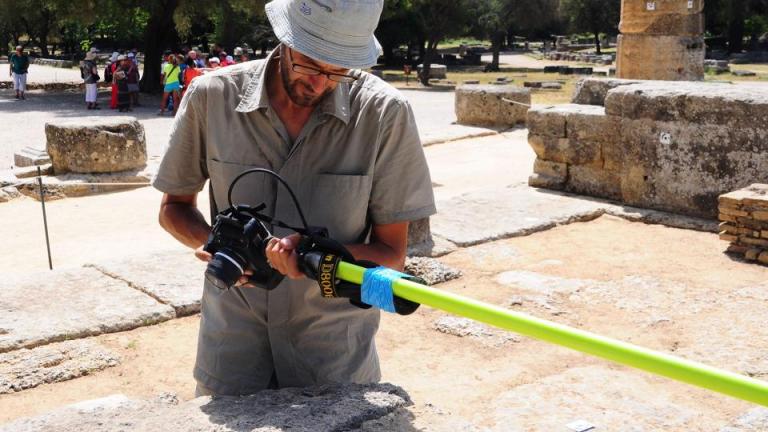
Sapirstein uses 3-D tech to further study of Greek Architecture
calendar icon09 Feb 2015
Lincoln, Neb.--UNL's Philip Sapirstein is using modern technologies to advance research into ancient Greek architecture.
As part of UNL's Center for Digital Research in the Humanities, the assistant professor of art history has launched the "Digital Architecture Project." The project uses digital photography and computer software to generate detailed, 3-D models of Greek temples, beginning with the Temple of Hera, a sixth-century B.C. structure at Olympia, Greece.
Sapirstein believes the research will overturn a longstanding theory about the temple's construction, while promoting the use of photogrammetry (a new method for creating 3-D models from photographs) in future studies of ancient architecture.
"There has been a lot of really revolutionary work in the last 20 to 30 years questioning old paradigms about the origins of Greek architecture, in particular the Doric style," Sapirstein said. "Researchers have been going back to the basics to reexamine evidence surviving from about a dozen well-preserved early temples in Greece, including Olympia."
Sapirstein has contributed to this shift in research into architectural history through his fieldwork examining stone architecture and terracotta tiles from sites in Greece, Italy, and Turkey — including Corinth, Corfu, and Olympia. He started the work in 2000 as a graduate student at Cornell University, first learning how to use computer-aided design software, then by using specialized 3-D scanners in the field.
“I wanted to make reconstruction drawings from ancient fragments and show how all this stuff fits together,” Sapirstein said. “I started out using bulky and expensive laser scanning units to make the 3-D scans. Now, I just use digital cameras and software.”
The new technologies have made the process relatively simple, inexpensive and fast. After positioning a network of survey markers across the temple/ruins, Sapirstein shoots a series of photos. Once uploaded to a computer, the photogrammetry software generates 3-D models by comparing photographs from different vantage points. The model of the temple can be viewed in its entirety or zoomed in to see details down to the millimeter.
“There is a lot of excitement about using this technique in the field of archaeology because the recording is much more complete and accurate than traditional methods, the cost is much lower, and it is fast,” Sapirstein said. “A number of archaeological excavations have started to use photogrammetry to generate 3-D models of their trenches. The Olympia project is one of the first to use this technique on something as big as a whole temple, so I will be publishing about the methods I developed there.”
The Hera temple measures about 170 by 65 feet and is Sapirstein’s largest 3D project thus far. He completed the photography in Olympia during the summers of 2013 and 2014. The first season focused on images at ground level; the second involved a 30-foot crane to capture the temple from the air.
“The crane allowed me to photograph the standing columns, which are about 5.3 meters tall,” Sapirstein said. “There are cuttings on top for horizontal beams which few people have been able to see before.”
And, UNL students are getting a preview of the work as Sapirstein incorporated a 3-D modeling project into a fall semester art history course on the history and topography of the ancient city of Jerusalem.
“Students learned SketchUp to create 3-D models of buildings and areas of the ancient city,” Sapirstein said. “Their projects were great, and I plan to continue adapting the format and work it into future classes.”
Along with the article on how to use this new 3-D modeling technique for architecture, Sapirstein has also lectured and written papers explaining how the Hera temple fits within the broader developments of Greek architecture and refuting a longstanding theory that the temple’s colonnades were once made of wood.
“I also plan to develop a website that can present this type of 3-D data in an accessible, reliable, and permanent way,” Sapirstein said. “Ultimately, that website — which will be part of the Center for Digital Research in the Humanities — will enhance a print monograph that presents all the new information we are learning about this major temple.”
--Troy Fedderson, University Communications